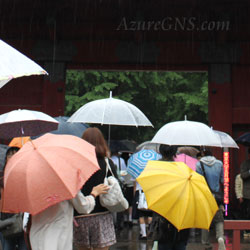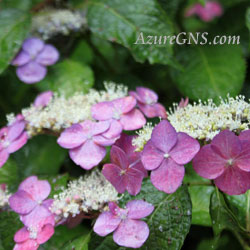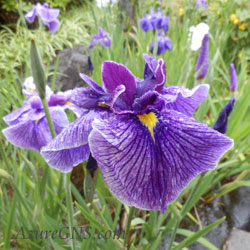(6月から7月まで)
Tsuyu
The Rainy Season
(from June to July)
●梅雨 Tsuyu; the rainy season
●梅雨前線 seasonal rain front
●梅雨入り the start of Tsuyu; the start of the rainy season
●梅雨明け the end of Tsuyu; the end of the rainy season
●空梅雨(からつゆ) dray rainy season
●長梅雨 long rainy season
●干ばつ drought
●洪水 floods
●気象庁 the Meteorological Agency
●公式発表 the official announcement
●紫陽花 hydrangea
●菖蒲 iris
●かたつむり snail
◆日本の雨期は梅雨と呼ばれます。
The rainy season in Japan is called Tsuyu.
◆梅雨は梅と雨という意味で、梅が熟れる季節に始まるのでこう呼ばれるようになりました。
Tsuyu means plums and rain, because Tsuyu begins when Japanese apricots are ripening.
◆気象庁は各地の梅雨入り(入梅)と梅雨明け(梅雨明け)を発表します。
The Meteorological Agency officially announces the start of Tsuyu (Nyubai) and the end of Tsuyu (Tsuyu-ake) in all regions.
◆だいたい5月初旬頃から7月末頃まで続きますが、その期間は日本の南部と北部ではかなり異なります。
It usually lasts from about the beginning of May until about the end of July, but its duration varies greatly between the southern and northern parts of Japan.
◆日本の南端の沖縄県の梅雨は5月上旬頃から6月末までです。
Tsuyu in Okinawa Prefecture, which is located in the southernmost part of Japan, is from the beginning of May until the end of June.
◆本州の北端の青森県の梅雨は6月中旬に入梅して、7月末に梅雨明けします。
Tsuyu in Aomori Prefecture, which is located in the northernmost part of the mainland, starts in the middle of June and ends at the end of July.
◆北海道には通常梅雨はありません。
Hokkaido usually has no rainy season.
◆最近は地球温暖化の影響で、豪雨が日本各地に大きな被害をもたらすことも増えてきました。
Nowadays, torrential rains often cause extensive damage all over Japan due to global warming.
◆梅雨の間、必ずしも毎日雨が降るわけではありませんが、雨の多い蒸し暑い季節です。
Though it does not rain every day during Tsuyu, it rains a lot, and it is very hot and humid.
◆梅雨は日本人にとって、特に農業に携わる人々とって、大切な恵の雨です。
Tsuyu is an important rain of blessing to Japanese people, especially to farmers.
◆田植えは梅雨に行われます。
Rice planting is done during Tsuyu.
◆梅雨の間に雨量が少ないと、水不足になります。
If the rainy season is very light, a water shortage may follow.
◆川、ダム、湖からの取水制限が行われます。
The amount of water taken from rivers, dams, and lakes is controlled.
◆水不足は農業だけでなく日常生活にも影響を与えます。
The shortage of water affects not only agriculture, but also daily life.
◆この頃、紫陽花や菖蒲が見頃を迎え、日本各地で紫陽花祭りや菖蒲祭りが開催されています。
During this season, hydrangea and irises are at their best, and hydrangea festivals and iris festivals are held all over Japan.
◆日本では、紫陽花や菖蒲は梅雨に咲く代表的な花です。
Hydrangeas and irises are representative flowers which bloom in Tsuyu.
◆遠足の前日など子供達は翌日天気になることを願って、てるてる坊主を作ることがあります。
Some children make Teru-teru-bozu (shine-shine-monk) on the day before a school excursion, hoping that the following day will be nice.
◆てるてる坊主は紙か布で作られた、手も足も無いシンプルな人形です。
Teru-teru-bozu is a simple doll made of paper or cloth, and it has neither hands nor legs.
◆てるてる坊主は軒下か、窓のそばにつるされています。
Teru-teru-bozu is hung under the eaves or near the window.
◆てるてる坊主の風習の歴史は長く、起源は江戸時代(1603-1867)中期頃だと言われています。
The custom of Teru-teru-bozu has a long history, and it is said that its origin dates back to the middle of the Edo period (1603-1867).
◆子供達は1921年(大正10年)に作られた童謡の「てるてる坊主」を歌うこともあります。
Children sometimes sing “Teru-teru-bozu”, a children’s song composed in 1921 (Taisho 10th yr).
(より詳しい情報は「我が家の梅雨」と「梅雨時に咲く花」をご覧下さい。)
(Please see “Our Rainy Season Experience” and “Flowers Bloom in the Rainy Season” for further information.)
Copyright (C) Azure Global Network Services. All Rights Reserved.







